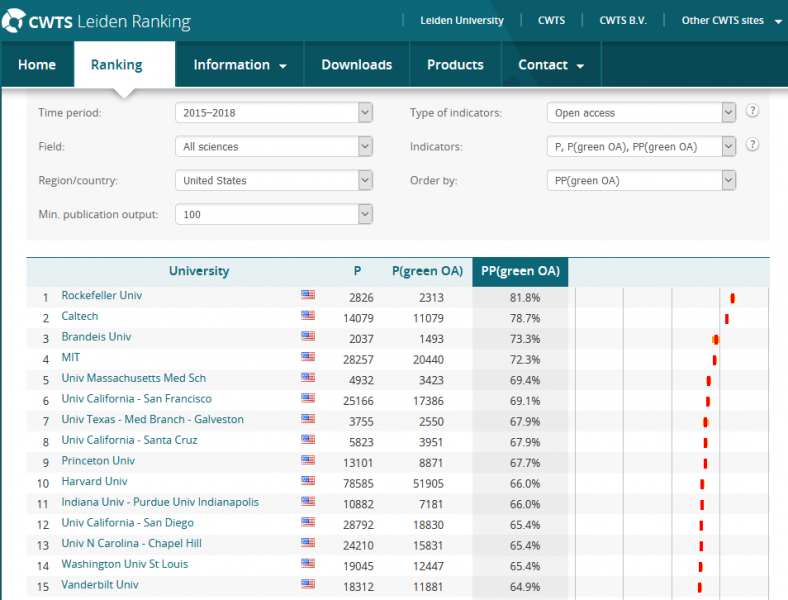In July 2020, the Centre for Science and Technology Studies at Leiden University released its latest ranking of university bibliometric indicators. The Leiden Rankings use new tools to characterize the bibliometric output of a university without relying on problematic, reputational proxies such as the Journal Impact Factor. In addition to the quantity of articles, authorship gender counts, and degree of collaboration, the rankings show how many articles are available open access (OA) to any reader with internet access, at no cost.
Did you know that there are several ways to make an article open access? In addition to an overall metric of publications made OA, the Leiden Rankings allow a user to filter the results by how the articles were made OA. Here’s the basic landscape for how articles are made open access:
Gold OA: These articles are open access because they are published in a journal that makes all of its articles OA. Sometimes people assume that “gold” means that the author has to pay an “article processing charge” to publish in these journals, but that’s not always the case. In fact, the majority of OA journals are sponsored by universities, scholarly societies, and other organizations. Of the nearly 15,000 OA journals indexed in the Directory of Open Access Journals, 73% do not charge authors a fee.
Hybrid OA: These articles are open access (often with a Creative Commons license attached) even though the journals that publish them are not open access journals. Most large, for-profit publishers offer an OA choice to the authors of pay-walled articles. If the authors pay a fee (usually about $3000.00), the journal will make that article OA even though the other articles in the same issue are probably paywalled. Many libraries think the “hybrid” road to OA is too expensive and a form of “double-dipping” on university budgets. If universities already support a journal by paying (an often hefty) subscription fee, why would universities also support the journal by paying another fee?
Bronze OA: These articles are open access because the journal made them free-to-read even though the journal might also charge subscription fees to libraries and other organizations. Of the roads to OA, “bronze” is the most variable and the least stable. The publishers of the open access articles generally hold all of the copyrights to the works and can choose to move them behind a paywall at any time. The articles are usually unavailable for data mining or reuse on other websites and, given that publishers still control how the articles are accessed, another way to think of these articles is … they’re free-to-read-for-now.
Green OA: These articles are open access because they were archived (before or after publication) in an OA repository such as IUPUI ScholarWorks or PubMed Central. “Green” OA must be implemented in accordance with the copyrights retained by the authors. Some journals permit authors and their funders or institutions to make the final, published version of an article OA in a repository. But most paywalled journals require authors to use the “accepted manuscript”--the final draft after peer review, but before journal design & copyediting. Authors do not have to pay a fee to make these articles open access--and, because they are included in a university or government repository, they can be trusted to be OA for the long haul. Over 80% of publishers permit authors to make at least one version of their article OA at no cost to authors or readers in a repository. But here at IUPUI, because our faculty adopted an open access policy, our authors retained the rights to the accepted manuscripts for all of their articles. In short, “green” OA is free to authors, free to readers, stable, and compatible with nearly every journal that an author might choose for their article.
IUPUI authors participate in all of these roads to OA, but the “green” road is where IUPUI truly excels. In accordance with the IUPUI OA Policy and with the assistance of librarians, IUPUI authors make over 66% of their journal articles free-to-read in IUPUI ScholarWorks. That percentage of participation in “green” OA puts IUPUI near the top of the list (#11) for universities in the United States--just behind Princeton and Harvard. (See Figure.)

Figure. U.S. universities ranked by: Type of indicators: Open access; Indicators: green OA; Order by: % green OA. (Screenshot from CWTS Leiden Rankings, July 21, 2020. https://www.leidenranking.com/ranking/2020/list.)
Providing free access to at least one version of an article in an institutional repository, like IUPUI ScholarWorks can increase citation rates for authors by 33%, but the benefits to the readers are both profound and difficult to measure. A one-time download of an article from a paywalled journal article can cost more than $25.00 for a reader who does not have access to a subscribing university library. In 2019 alone, readers downloaded articles from the IUPUI Open Access Policy collection more than 790,000 times, which would approximate to a cost savings of nearly $2 million to readers. The exact uses of these downloads are largely untold, but, by making these articles open access, IUPUI’s authors are contributing to research, education, and to the general interest of curious readers everywhere.
